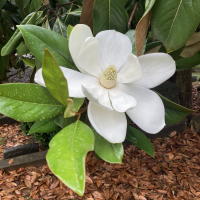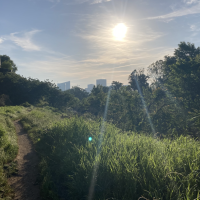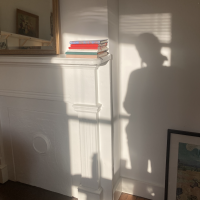| title | place | type | year |
|---|---|---|---|
| In conversation with Laurel Schwulst and Vida Rucli | Robida Radio | radio interview | 2025 |
|
Vida Rucli of Robida Collective invited Laurel Schwulst and I to talk about our Sense to Sense class this summer. “Branching In, Branching Out,” Vida’s show for Robida Radio is about learning and pedagogical experiments, and is broadcast from the collective’s home village of Topolò / Topolove in the Italian/Slovenian mountains. 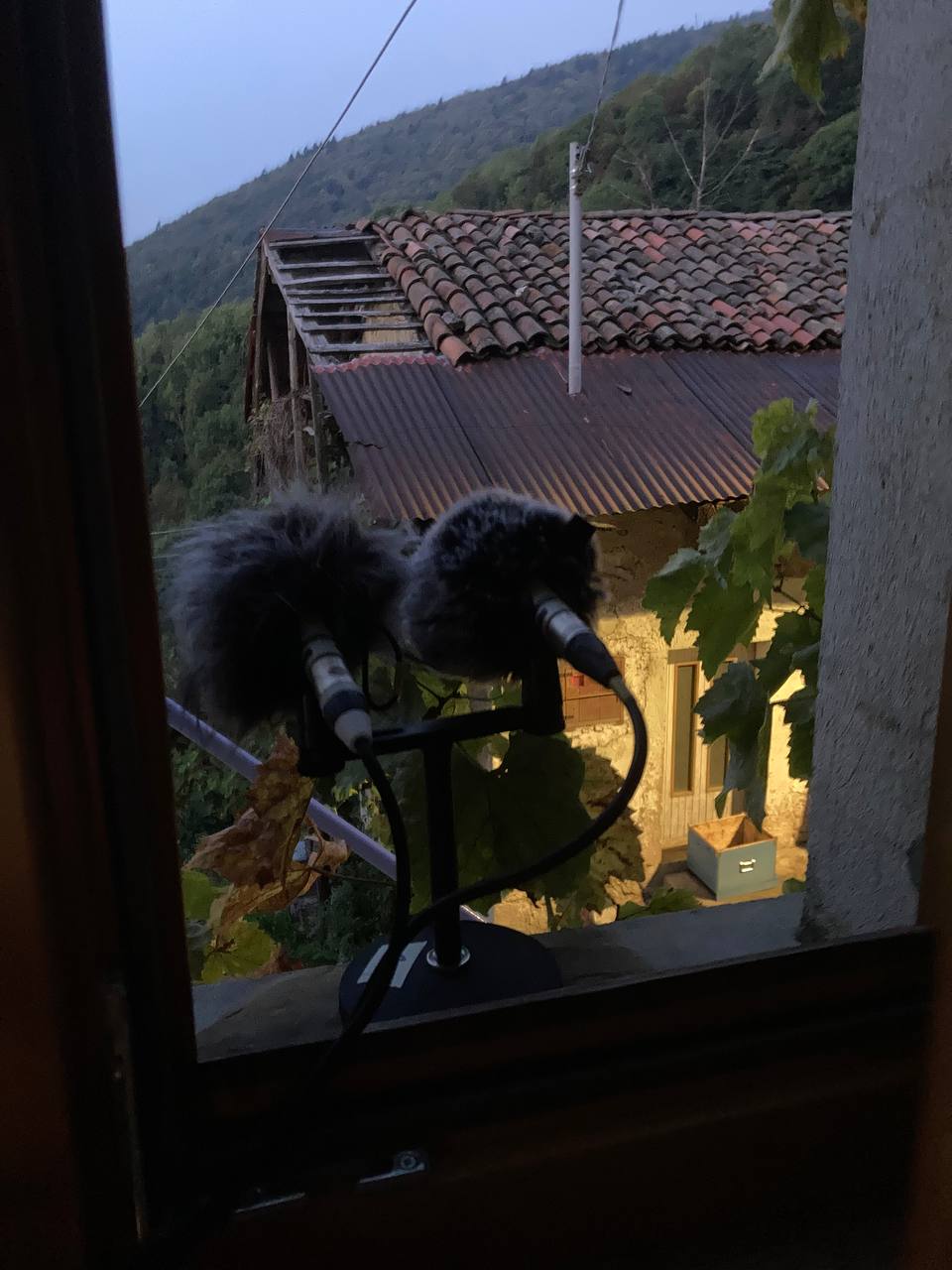 |
|||
| On the process being the work | Ness Books | book essay | 2025 |
|
An essay for a book by the textile artist Aliki van der Kruijs, which comprises scans of her entire studio archive. For 12 years Aliki saved samples, textures, pigments, scraps, newspaper clippings, print ephemera, photos, and writing. She housed them in thin cardboard boxes and thick black binders and stored them on her studio shelves. The book publishes this archive of source material, along with entries from her grandfather’s 12 notebooks documenting the weather for 24 years. Aliki's work is a lot about weather, nature, cycles, seasons, and time, and I love that she wanted to make a book about the process of making, rather than the output. My essay is about meandering through her archives. |
|||
| A Sexual History of the Internet by Mindy Seu | Metalabel | book | 2025 |
|
A SEXUAL HISTORY OF THE INTERNET is an artist book by Mindy Seu, adapted from a performance lecture of the same name. The book is a polyvocal retelling of sexual technologies in five chapters — less an abridged history, and moreso a collection of experiences, anecdotes, and historical artifacts that reveal the pervasive and perverted origins of many of our digital tools. Alongside the lecture, an introduction by Mindy, and beautiful design by Laura Coombs, one of my favorite parts of this project is how the profits are distributed among not only everyone who worked on the book, but everyone with works cited in it. A feminist theory of citational praxis made material. |
|||
| Co-teacher | Ultralight School | class | 2025 |
|
With Laurel Schwulst for her school Ultralight, a writing and publishing class about translation and the senses. Over five weeks, participants engage in readings and discussion about the five senses and explore what it means to carry sensations over into written form. How can a fragrance become a poem? What are the different ways to write an image, or to document a sound? Ursula K. Le Guin says, “all writing is translation” — from the perceptual into language. Similarly, we look toward the senses to expand our use of language and to strengthen our writing voices. By the end of class, we’ll collect and publish some of our experiments into a publication. |
|||
| Guest Lecturer | Princeton | talk | 2025 |
|
A lecture on translation and writing the senses for David Reinfurt’s r-e-s-e-a-r-c-h class at Princeton. 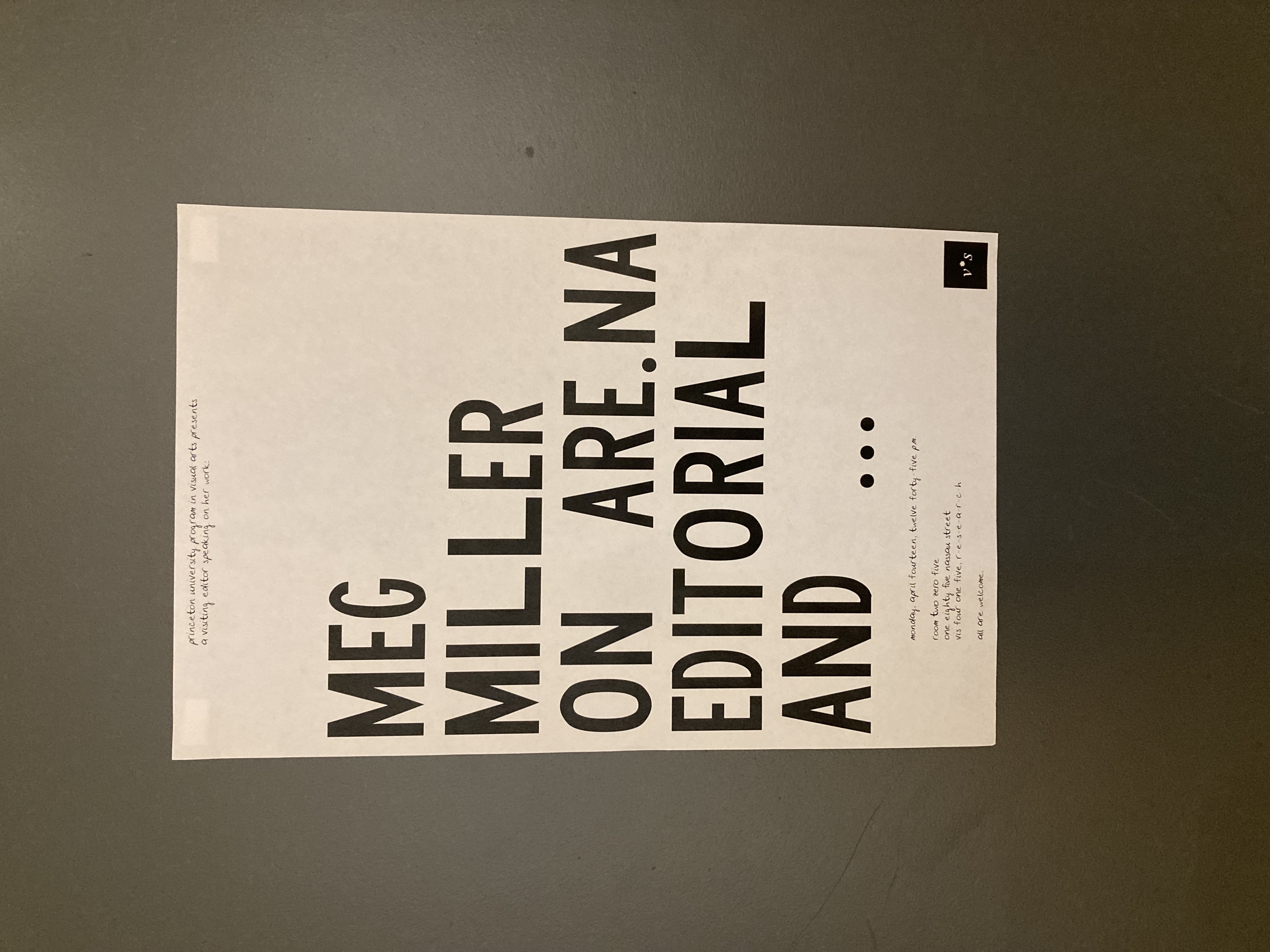 |
|||
| Guest Critic | Yale | crit | 2025 |
|
Invited by Nontsi Mutiti to be a guest critic on the thesis review panels for MFA second year graphic designs at Yale School of the Arts. |
|||
| Say Sense is Not Everything | Virginia Commonwealth University | student publication | 2025 |
|
Say Sense is Not Everything is a print and online publication that arose out of the Spring 2025 graduate seminar “Sense-to-sense Translation.” If in the first part of the seminar we focused on translation across the senses, in the second half things took a turn — toward the untranslatable. We started asking ourselves, What happens when language fails us, or stops itself or stutters? Is scarred or silenced or broken with grief. How can we write into a space of uncertainty or unknowing? What do we do with the untranslatable? The essays in this book attempt to answer these questions, and are written by the participants in the seminar: Rasim Bayramov, Hwiy Chang, Molly Garrett, Tariye George-Phillips, Aya Khalifeh, Diego Pablo Màlaga, Nneoma Njoku, Tyna Ontko, Irene Piazza, Quinn Standley, Weitong “ShanMu” Sun, Lorna Williams, and Wren Tiffany. They are each really moving in their own way, they say a lot with a little, and they are beautiful examples of how circling around the thing can bring us closer to the essence and the truth of the experience than saying it directly. Book designed by Rasim Bayramov, Molly Garrett, Aya Khalifeh, and Nneoma Njoku. Website design by Weitong “ShanMu” Sun and Tariye George-Phillips. |
|||
| On shimmering | the html review | visual essay | 2025 |
|
Together with Mariah Barden Jones, a fragmented piece on water and light, fracturing and movement. A collection of texts that shimmer, in this case literally, thanks to Mariah’s coding and creative direction. |
|||
| Adjunct Professor | Virginia Commonwealth University | seminar | 2025 |
|
A graduate seminar for the graphic design department at VCU in Spring 2025. In a sense, all writing and art-making is an act of translation — an approximation of the original source, idea, or feeling, rendered into something new. Translation can also happen across media or senses: art writing, at its best, translates perception and sensation into language. Graphic notation visualizes sound; architectural notation turns space into symbols. In this seminar, we’ll look at work that manifests in many different forms and consider what’s gained and what’s lost in translation. We’ll also build a writing practice, with a special focus on writing the senses: visuals, sound, scent, etc. We published a book and a website of our writings (Say Sense is Not Everything) a weekly newsletter (Bad Sense) over the course of the semester. |
|||
| On political hopelessness and how we can’t afford it | The Morning News | roundup | 2024 |
|
Big title for a little mention, but...here I am in The Morning News’ annual The Year That Was and Wasn’t roundup, talking about what happened (and didn’t) in 2024 alongside many writers I admire. |
|||
| Are.na Annual 2025, “document” | Are.na | book | 2025 |
|
A yearly anthology of writing from the people of Are.na. This year, the Annual is themed “document,” as in to record; to provide information or support; an official paper or digital file; a piece of evidence, a form of proof. Read more about what’s in the Annual in the Editor’s Letter. Contributors include Yeaye, Will Allstetter, Chia Amisola, Raegan Bird, Nathalia Dutra, Nika Simovich Fisher, Jonathan Sölanke Gathaara Fraser, Lu Heintz, Mariah Barden Jones, Steve 성민(Seongmin) Ju, Amelia K., Prairie Koziol, Joanne Lam, James Langdon, Marvin Renfordt, Reuben Son, Matthew Stuart, Gerardo Ismael Madera, Kalina Nedelcheva, Sharon Neema, Audrey Robinovitz, Finnegan Shannon, Megumi Tanaka, Luna Wang, and Iris Xu. |
|||
| Century Scale Storage by Maxwell Neely-Cohen | Harvard Library Innovation Lab | essay | 2024 |
|
While a fellow at the Library Innovation Lab at Harvard Law, Maxwell Neely-Cohen wrote an extremely thorough and compelling essay/report on the future of digital storage, framed around the question: If you had to store something for 100 years, how would you do it? I was brought in as one of the editors on the project, which was designed by Shelby Wilson and Alex Miller and published as a website. |
|||
| On Chia Amisola’s “ambient internet” | BOMB | interview | 2024 |
|
“I call these works ‘internet ambient,’ where I’m interested in reconfiguring our attention to the web: What is visible, invisible, foregrounded? How does poetry emerge from the landscape of the browser?” For BOMB I interviewed internet artist and poet Chia Amisola about the dense digital environments they build with their poetry. |
|||
| On metaphors and memory | Dirt | essay | 2024 |
|
An essay on memory, the mind, and the limits of the brain-computer metaphor. A personal one for me; grateful for the care, trust, and editorial guidance from Daisy Alioto, and first reads from Jessi Haley and Kai Schnier. |
|||
| On forest gardening | Are.na | interview | 2024 |
|
As a part of Ecologies of Entanglement, a collaborative series between Are.na Editorial and the newsletter Dark Properties, I interviewed Casey Tang on forest gardening, complex systems, and mapping ecological design onto software methodologies. |
|||
| On satellite imagery and ways of seeing | Dark Properties | interview | 2024 |
|
As a part of Ecologies of Entanglement, a collaborative series between Are.na Editorial and the newsletter Dark Properties, I interviewed Agnes Cameron on satellite imagery and ways of seeing that go beyond the human eye. |
|||
| Polyphonic Shimmering | Virginia Commonwealth University | student publication | 2024 |
|
Polyphonic Shimmering is a print and online publication that came out of a seminar I taught to MFA students at VCU in spring 2024. Each piece starts with an image, and was the final project of a seminar that explored how visual writing can be and how language-based image-making can be. From my introduction: “These pieces shimmer and hum, they play with duration and pacing and expand language beyond its conventional encasements. They allow us to see what they see, in ways both visual and textual, but mostly through language that blurs the distinction between the two.” Polyphonic Shimmering was featured in Kristoffer Tjalve’s Naive Weekly newsletter and Caitlin Dewey’s Links newsletter. |
|||
| Desire Paths symposium | Virginia Tech | talk | 2024 |
|
A talk about image and text at the Desire Paths symposium at Virginia Tech, organized by Mariah Barden Jones and Raegan Bird. |
|||
| On the past, which is always present | Los Angeles Review of Books | interview | 2024 |
|
An interview with Tracy Fuad on PORTAL, her new book of poems about the things we inherit—memory, language, culture—and how being in a new place can cast these things into a different relief. |
|||
| naive-yearly.are.na | Are.na | publication | 2024 |
|
A digital publication of eight works from Are.na and Naive Yearly, a conference on the quiet, odd, and poetic web. Featuring pieces from Chia Amisola, Elliott Cost, Benjamin Earl, Tiana Dueck, Laurel Schwulst, Marty Bell, Maya Man, Alice Yuan Zhang, and Kristoffer Tjalve. |
|||
| Are.na Radio | Montez Press Radio | radio | 2024 |
|
For Montez Press Radio, Rigoberto Lara Guzmán, Michelle Santiago Cortés, Sharon Neema and I talked about what we’ve been thinking through by way of an Are.na channel. I wrote a meandering intro essay on shimmering ideas, language, and writing as image-making. Rigo spoke about rural electrification and energetic futures. Michelle ruminated on blood, mysticism, Vampires as hyper-Catholics, and “collaboration as contamination.” And Sharon went deep on attention, notetaking as an act of noticing, and small repeated acts of care. |
|||
| Guest Lecturer | Triple Canopy Publication Intensive | session | 2024 |
|
One day seminar as part of Triple Canopy’s annual Publication Intensive. We explored everyday archiving and personal research practices, looking towards publications that narrate the processes of their own making, and considered how the visual language of contemporary platforms and media shape, structure, and sequence those processes. |
|||
| Visiting Professor | Virginia Commonwealth University | seminar | 2024 |
|
A graduate seminar on writing for the graphic design department at VCU. Through readings, discussion, and writing exercises, the class explores images and ideas that “shimmer around the edges” (Didion) and writing as the “shimmering go-between” (Nabokov). The first section looks closely at writing that starts with the image — whether a photograph, artwork or memory — and considers that if designers and artists are perhaps more equipped than most at preserving those images, understanding their importance, and making them legible to themselves or to others, then writing can be thought of as just another form of image-making. The second half of the semester engages with writing that starts with collection or accumulation. We’ll sit with the sort of shimmering that happens when you come across an image, an object, or a passage in a book that resonates, and the kind of meaning-making that writing can do when it connects the disparate material that makes up one’s interests. Readings include Annie Ernaux, Christina Sharpe, Toni Morrison, Saidiya Hartman, Naomi Shihab Nye, Renee Gladman, Dodie Bellamy, Nathalie Léger, Valeria Luiselli. |
|||
| Are.na Annual 2024, “trace” | Are.na | book | 2024 |
|
The 2024 Are.na Annual is themed “trace,” as in to find or discover through investigation; to copy, sketch, or superimpose; a mark, a sign, an inkling, a glimpse. Read more about this year’s anthology in the Editor’s Letter. Contributors include David Reinfurt, Terry Nguyen, Daniela Bologna, Jon Chen, yana m’baye, Shelby Wilson, Amirio Freeman, Michelle Santiago Cortés, Sarah Chekfa, Michelle Kuan, Noa Mori Machover, Desmond Wong, Sanaa Asim, giorgia chiarion, Andrew Walsh-Lister, Laurel Schwulst, Tracy Ma, Christophe Clarijs, Sean Catangui, Meghna Rao, Lester Rosso, and Scott W. Schwartz. |
|||
| Guest Lecturer | Parsons School of Design | talk | 2023 |
|
“Shimmer Around the Edges,” a lecture on writing images for graduate students in the Visual Culture seminar. |
|||
| Unlicensed by Ben Schwartz | Valiz & Source Type | book | 2023 |
|
Editing for Ben Schwartz’s book of interviews on bootlegging as creative practice. |
|||
| On Hedda Sterne’s aerosol paintings | feeeels | essay | 2023 |
|
For feeeels magazine, an essay on Hedda Sterne’s aerosol paintings and New York as “a carousel in continuous motion.” |
|||
| On secret languages | Spector Books | book essay | 2023 |
|
An essay for D is for Daughter, an artist book by Elina Birkehag that details her project researching and photographing the marks and messages left on the trees by young women shepherds in her hometown of Dalarna, Sweden. From the 17th to the early 20th centuries, young, unmarried women in the area would leave their villages to live and work together on the fäbod (summer farm) and lead their families’ cattle out to graze. While in the pastures, these young women, many of them teenagers, carved the date, their initials, and notes to each other, leaving the trunks scrawled with a kind of teenage freneticism, a coded language, an assertion of their existence: HERE WE DRAW OUR NAMES. I wrote an essay for the reader section of the book, alongside contributions by Amelia Groom & M. Ty, Quinn Latimer, Jungmyung Lee, Matilda Kenttä & Linnea Rutz, and Jennie Tiderman Österberg. “Wood for the Trees: and other things we cannot see” is about secret languages, trees talking, messages hidden in plain sight, and memory work, which is so often women’s work. “Embroidered into clothing, carved into trees, written into decades-old scientific papers, this work might linger on the edges, or be shrouded in innocuousness. It might hide in plain sight until someone is ready to look, the only key needed to break the code. Attention is a crucial precursor of understanding, and to give something your attention you must first see it. The shepherds must have known that too; they often began their messages with SI, meaning ‘look here.’ ” |
|||
| Guest Critic | Princeton | crit | 2023 |
|
Guest critic for the final projects of students in David Reinfurt’s class on design research. |
|||
| Are.na Annual 2023, “service” | Are.na | book | 2023 |
|
A yearly anthology of writing from the people of Are.na. This year, the Annual is themed "service," as in an act of helping or supplying; to repair or maintain; to provide a public need; a meeting for worship, a place to refuel. Read more about what's in it in my Editor’s Letter. Contributors include June T. Sanders, Tiger Dingsun, Chris Rypkema, Morgan Strahorn, Miaoye Que, Jo Suk, Maxwell Neely-Cohen, Teah Brands, Molly Soda, Ada Popowicz, Aisha Ghei Dev, Alice Yuan Zhang, Zander Abranowicz, Cindy Hwang, Luiza Dale, Tuan Quoc Pham, Stepahnie Marie Cedeno, Charlotte Strange, Adriana Gallo, Rohan Chaurasia, Michael Norman, Robin Mendoza, Michelle Jia, Moon Mokgoro, Imani Cooper Mkandawire, Sharon Park, and Carolyn Li-Madeo. Book design by Leslie Liu and Daniel Pianetti, and beautiful cover design by Rohan Chaurasia. |
|||
| In-conversation with Malte Mueller, Louise Kunth, and Charles Broskoski | ISLAND | in conversation | 2023 |
|
A conversation about Are.na and the Are.na Annual at the event space ISLAND in Hamburg, followed by people presenting their Are.na channels. Put on with the Klasse Digitale Grafik Klasse at HFBK. 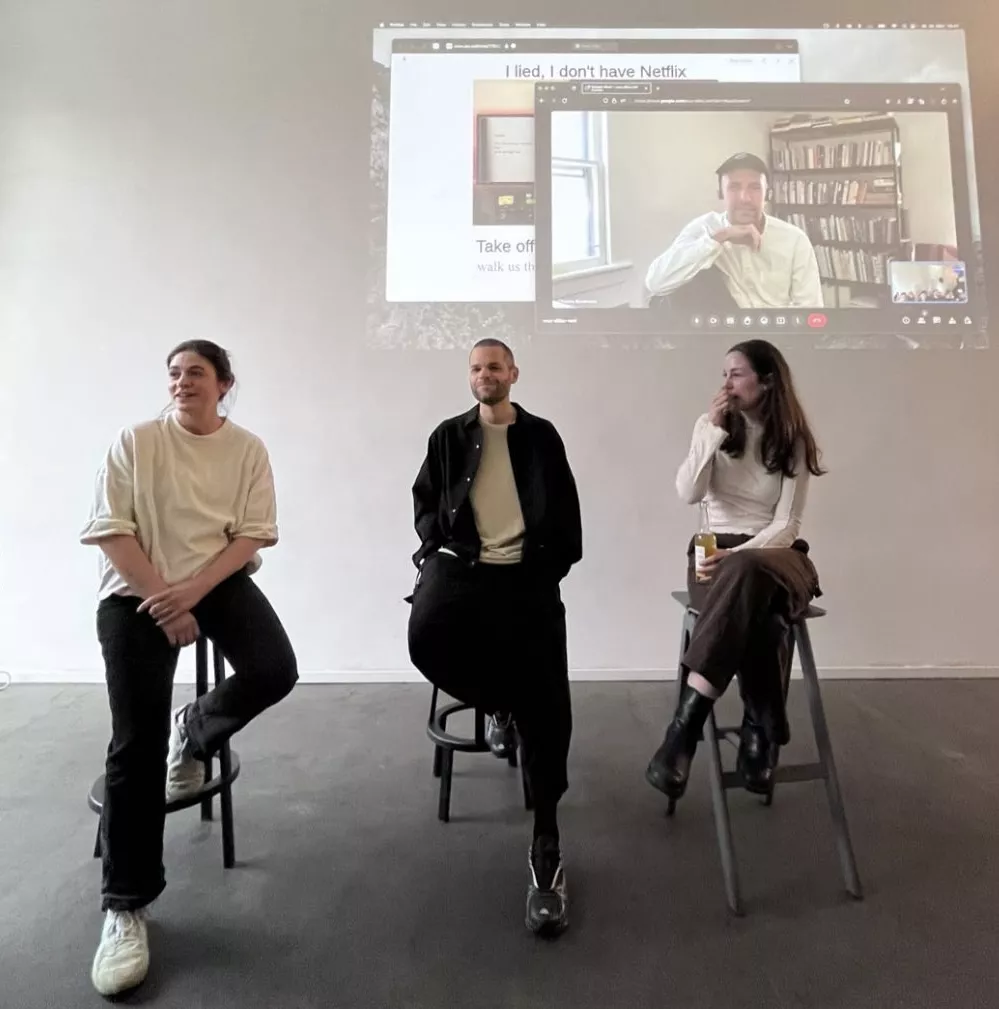 |
|||
| On transdimensional thin spots | Catalog | essay | 2024 |
|
For Catalog, a short essay on Berlin’s mythic landscape and the places where the walls between worlds grow thin. |
|||
| On Border Ecologies | Mold | feature | 2024 |
|
In April 2022, I wrote an article about a project from the Foundation for Achieving Seamless Territory (FAST) about the Qudaih family farm near the border in Gaza. FAST’s work is concerned with the relationship between architecture, spatial planning, and human rights in conflict areas, and this project traced the evolution of the natural ecology of the Qudaih farm in response to the stressors of war. Magazine production got held up for a couple of years so the piece was only just now published, in its original format, in 2024. |
|||
| On a set of rules, impossible to follow | Manual.land | liner notes | 2022 |
|
An essay introduction to Mitko Mitkov’s text and sound project MANUAL, a Telegram group-turned-website and, soon, album. |
|||
| Shift | Estonian Academy of Arts | student publication | 2022 |
|
Shift is a collective publication designed and developed by EKA students specifically to exist on the web. Through hands-on editing, coding, readings, and discussions, the authors of the publication looked at examples of poetic and experimental webzines to gain an understanding of the history and context for digital publications, and explore the parameters of the web as a medium for publishing (as well as how to subvert them). This course was facilitated by Julia Novitch and Meg Miller and took place over Zoom and in-person with two full-day workshops at the Estonian Academy of Arts (Master in Graphic Design) in November 2022. |
|||
| Visiting Professor | Estonian Academy of Arts | seminar | 2022 |
|
A seminar on digital publishing at Eesti Kunstiakadeemia for Masters graphic design students, co-taught with Julia Novitch, learning about the poetics and parameters of webzines. At the end of the course, we collectively created our own online publication: Shift. |
|||
| On the gender star | Source Type | essay | 2022 |
|
An essay on the evolution of the gender star, an asterisk placed within German nouns to denote gender inclusivity and neutrality. Similarly seen in other languages with gendered nouns, the gender star is a “typohack” (to use a term by designer Hannah Witte) — an imperfect but necessary quick fix as language catches up with cultural and societal change. A radial representative of omission, transition, and change, the asterisk has over time become a kind of symbol for the malleability of language. Accompanied by a visual essay by Mindy Seu and Laura Coombs. |
|||
| Stine Janvin and Cory Arcangel conversation | Primary Information | text | 2022 |
|
Editing for an interview between the two artists for Identity Pitches, a book of conceptual music scores that Cory and Stine based on the knitting patterns for traditional Norwegian sweaters known as Lusekofte. Their conversation gives context to the work by delving into the history of Norwegian folk music tunings and the knit patterns, and their intersection with the cultural identity of the country over the last millennium. |
|||
| Feral File | Feral File | exhibition materials | 2022 |
|
Editing exhibition materials and editorial pieces for digital art gallery Feral File, co-founded by Casey Reas. |
|||
| On websites, which are never ready | Lerchenfeld | article | 2022 |
|
A write-up for HFBK Hamburg’s Lerchenfeld magazine of the Never Ready conference, held by the Klasse Digitale Grafik. As Konrad Renner puts it, “Change, wanted or not wanted, is a substantial part of working with websites. It’s intrinsic, deeply embedded in the DNA of the medium.” |
|||
| On logic and leakage | Automatic Editions | book essay | 2022 |
|
An essay for Coral Saucedo Lomelì’s artist book An Incomplete History of Pierced Vessels, on holes, women, water, sieves, and “fatal formlessness.” The essay, titled “There’s a Logic to this Leakage," was in response to Coral’s beautiful clay vessels — sometimes long and tubular, other times slick and pitted; turned upside down, they became drains, sieves, then sculptures, glazed and stacked like totems, broken into shards or printed onto paper. The book itself is also riddled with holes — what is held is just as important as what is let through. |
|||
| Thesis crit | Estonian Academy of Arts | jury review | 2022 |
|
Part of the jury for the first graduating cohort of the EKA graphic design MA program |
|||
| Source Type | Source Type | publication | 2022 |
|
Editorial for Source Type, a platform for typographic research and visual literacy from Laurenz Brunner. |
|||
| Multidimensional Citations by CSS | The Serving Library | essay | 2022 |
|
Editing for the first draft of Multidimensional Citations by Laura Coombs, Laurel Schwulst, and Mindy Seu, which was later commissioned and edited by The Serving Library. |
|||
| A Vast, Pointless Gyration of Radioactive Rocks and Gas in Which You Happen to Occur | A24 | book | 2022 |
|
Editing for a book published by A24, with filmmakers Daniel Kwan and Daniel Scheinert, about the multiverse. We commissioned some writers, illustrators, poets, scientists, philosophers, and quilters we admire to make work about the different multiverse scenarios, and came away with was a book about perspective, possibilities, myth-making, and information overload. Featuring works by Ted Chiang, Esme Weijun Wang, Etgar Keret, Emily Segal, Raymond Queneau, Jorge Luis Borges, and many more. Published in March 2022, alongside the Daniels’ movie Everything Everywhere All At Once, which also takes place across the multiverse. |
|||
| On alt-text and describing the web | The New York Times | feature | 2022 |
|
An interactive piece on alt text, the image descriptions tucked away in a website’s HTML, which people who are blind or have low vision often rely on when navigating the web. There are billions of images online, and only a small fraction of them are accessible in this way. Together with Ilaria Parogni, we talked to the people who are working to change that. |
|||
| On Ruth Wolf-Rehfeldt | Desired Landscapes | essay | 2021 |
|
"Holes in the Wall" is an essay for Athens-based Desired Landscapes magazine, on Ruth Wolf-Rehfeldt, the "typewritings" that she mailed all around the world from behind the Berlin wall, and growth. Wolf-Rehfeldt believed in a future better than the bordered one she lived in, which is why she made and mailed her artwork, making the wall “full of holes,” to quote curator Valerie Hortolani. |
|||
| The Life and Death of an Internet Onion, s2 | Self-published | publication | 2021 |
|
“It's basically just a bunch of people musing on the possibility of expressing love online, how love exists online, things like this.”—Laurel Schwulst I edited the second season of THE LIFE AND DEATH OF AN INTERNET ONION, a layered webzine about the possibilities of love online. Season one published the writing of Laurel’s students at Yale, who also conceptualized the site, while this year’s contributions were from students at VCU as well as a few friends from the internet. Like any non-refrigerated onion, the "internet onion" has a shelf life of five weeks, during which it will slowly start to decay before dying completely. It comes back perennially in late summer and begins its cycle anew. This year's 15 new entries are naturally closest to the center, since onions grow new layers from the inside-out. As curator Cori Olinghouse has put it, "Temporalities animate life...Rather than saving and preserving what otherwise might be lost, [the internet onion] invites visitors to move through states of change. There isn’t the possibility to grab and take hold." |
|||
| In-conversation with Mindy Seu, Shannon Mattern, and Dan Taeyoung | Internets of Everything | in conversation | 2021 |
|
A conversation, organized and moderated with Are.na, for the Billion Seconds Institute series "Internet(s) of Everything" around the question of “How can we be generous with our curiosity online?” Participants were Mindy Seu, Shannon Mattern, and Dan Taeyoung, each of whom is very generous with their teaching, organizing, and presenting their interests online. |
|||
| On Aarati Akkapeddi’s memory work | The New York Times | feature | 2021 |
|
A piece for the "Surfacing" column at the Times on artist Aarati Akkapeddi’s work "I know if I walked in your footsteps, it would become a ritual," a series of machine-generated images of their mom, Sudha Akkapeddi. The images are deeply saturated and slid softly out of focus, more painterly than photographic, with a haziness that hints at the elusiveness of memory. I love this memory work that Aarati is doing with GANs, which they relate to the process of remembering—in each case, it's an approximation. |
|||
| On algorithmic apparitions | The Broadcast | essay | 2021 |
|
For several years, Aarati Akkapeddi has been collecting hundreds of photos from family members, scanning them, and sorting them—a process combining both automation and manual labor—then training a Generative Adversarial Network (GAN) on them to produce a composite of each person’s digital likeness. Inputting several decades’ worth of photos of their mother, for instance, results in a morphing portrait that bears a striking resemblance to the subject, while still seeming to search for her features. Fuzzy and unfixed, a spectre more familiar than accurate, the composite image looks uncannily close to how memory feels. |
|||
| On Soft Protest Digest | Mold | interview | 2021 |
|
For Mold’s Urban Ecologies series, an interview with Soft Protest Digest, a research collective founded by Nickie Sigurdsson, Robin Bantigny, and Jérémie Rentien Lando. For the past two years, they’ve been developing “environmentally and culturally resilient” dishes that take into account both the environmental footprint of the ingredients and the food’s cultural resonance. With each of their projects, The Soft Protest Digest shows how a sense of place and connection to the local is essential for forming new food traditions, and why forming new food traditions is so necessary in our current climate crisis. |
|||
| On digital literary magazines | Frieze | article | 2023 |
|
An article about the nascent little world of digital literary magazines and the interactive stories and computational poetry that are meant to exist on the web. Working with both words and code, these writers inventively use the browser as their medium, playing with duration, mutation and possibility. |
|||
| On art that dismantles language | Eye on Design | feature | 2021 |
|
In 1967, Robert Smithson wrote in a press release for an exhibition of language-based art (which he famously described as consisting of “Language to be Looked at and/or Things to be Read”) at the Dwan Gallery in New York, “Here language is built up, not written.” Art that dismantles language, isolates it from its meaning, and treats it as object has proliferated ever since. In a non-comprehensive survey of artists who work with typography, I explore how with these works we can defamiliarize ourselves with how language is made and used, and lose ourselves in the letters and the expressive possibilities of language and the many ways it can live in the world. |
|||
| Are.na Annual 2022, “portal” | Are.na | book | 2022 |
|
This year’s Annual is themed “portal,” as in an opening or point of entry, in the form of a website, gate, door, or hatch; an approach; a way to get or do something, a portal to. Contributors include Njari Dimario Anderson, Evelyn Bi, Agnes Cameron, Cortney Cassidy, S.A. Chavarría, Ayana Zaire Cotton, Madelyne Cummings, Ariel Dong, Sophia Dorfsman, Paige Emery, Elena Flores, Laura Houlberg, Leslie Liu, Tess Murdoch, Cori Olinghouse, Cedric Payne, Brixton Sandhals, Laurel Schwulst, Travess Smalley, Roque Strew, Mike Tully, Alex Turgeon, Bryce Wilner, Lukas WinklerPrins, and Rue Yi. Book design by Daniel Pianetti and Leslie Liu, and cover design by Ayana Zaire Cotton. |
|||
| Are.na Annual 2021, “tend” | Are.na | book | 2021 |
|
Our second Aren.a Annual was themed ”tend,“ as in to care for or manage, to give your attention to, or to move toward a particular direction, an inclination or “tendency.” Contributors include Rona Akbari, Zainab Aliyu, American Artist, Weeda Azim, neta bomani, fiona carty, Juliana Castro, R.C. Clarke, Shea Fitzpatrick, Melanie Hoff, Madeline Hsia, Clemens Jahn, Lucy Siyao Liu, Omar Mohammad, lily nguyen, Emma Rae Bruml Norton, Lai Yi Ohlsen, Alice Otieno, William Pan, Elizabeth Perez, Ingrid Raphael, Charlie Reynolds, Michael Bell-Smith, and Austin Wade Smith. |
|||
| On Karen Blixen’s flowers | Are.na | essay | 2021 |
|
Karen Blixen was a baroness and a Danish author best known for her books Seven Gothic Tales, Out of Africa, and Babette’s Feast. She wrote under the pen name Isak Dinesen, wore ornamental hats and giant fur coats, and was one of the 20th century’s most essential authors, per Margaret Atwood. She was also, apparently, a gardener, as well as a talented, intuitive, somewhat unhinged arranger of flowers. |
|||
| Ecology + Design session | AIGA Design Conference | talk | 2020 |
|
For the 2020 AIGA Design Conference, I organized and led a session around environmentalism and design, featuring Benedetta Crippa, Jarrett Fuller, Julia Watson, Anoushka Khandwala, Joycelyn Longdon, Melina Laboucan-Massimo, Jonny Black, and Scott Starrett. |
|||
| The Life and Death of an Internet Onion | Yale | publication | 2020 |
|
In April 2018, 2018, Fei Liu wrote the essay “A Drop of Love in the Cloud” for Are.na and The Creative Independent. In April 2019, Laurel Schwulst asked me to work on a publication with her interactive design class at Yale that responded to this piece. She prompted her class, “What are other love inputs that might allow us to ‘reach across the chasm of a seamless signal’?” The answers were layered, they spoke toward duration and the possibilities of loving someone from a distance. We made the publication an onion, and like other onions, it has a shelf-life of 5 weeks, after which it will slowly rot and die. It may be dead now, depending on when you're reading this, but this publication is perennial, so it will be live again in April 2021. |
|||
| On The New Women’s Survival Catalog | The New York Times | feature | 2020 |
|
In 1973, Kirsten Grimstad and Susan Rennie quit their jobs, rented a green Plymouth Duster, and drove 12,000 miles across the country to document a nationwide network of feminist alternative culture and resources. They visited feminist bookstores, printers, divorce co-ops, credit unions, dropped in on Rita Mae Brown and Judy Chicago, and in one case, tracked down an agriculture collective in California by asking around for the “women goat farmers with an octagonal barn.” The result is The New Woman’s Survival Catalog, the “feminist Whole Earth Catalog,” which was a bestseller in 1973 that all but disappeared before getting a recent reissue. |
|||
| On Christoph Knoth and Konrad Renner | Lerchenfeld | interview | 2020 |
|
For HFBK Hamburg’s Lerchenfeld magazine, an interview with designers Christoph Knoth and Konrad Renner of Knoth & Renner about digital publishing, the handmade web, the unlikely endurance of the PDF, and websites that replicate, then disappear. |
|||
| Guest Lecturer | American College of Greece | talk | 2020 |
|
A lecture on design writing for the History of Graphic Design and Contemporary Graphic Design classes at the American College of Greece. |
|||
| Are.na Annual | Are.na | book | 2020 |
|
A printed book about the past, present, and future of the Internet, with republished essays from the blog and five new, never-before-seen pieces. Alongside a three-part essay “When It Changed” on witnessing the backlash against the corporate-owned Internet, the writings in the book explore and celebrate the creative, poetic, and personal potential of the Web. Contributions by Becca Abbe, Cory Arcangel, Omayeli Arenyeka, Charles Broskoski, Claire Evans, Will Freudenheim, Willa Koerner, Jasmine Lee, Eric Li, Meg Miller, Mimi Onuoha, Andy Pressman, David Reinfurt, Danielle Robinson, Rachel Rosenfelt, Laurel Schwulst, Mindy Seu, Leo Shaw, Toph Tucker, Karly Wildenhaus, and Gary Zhexi Zhang. 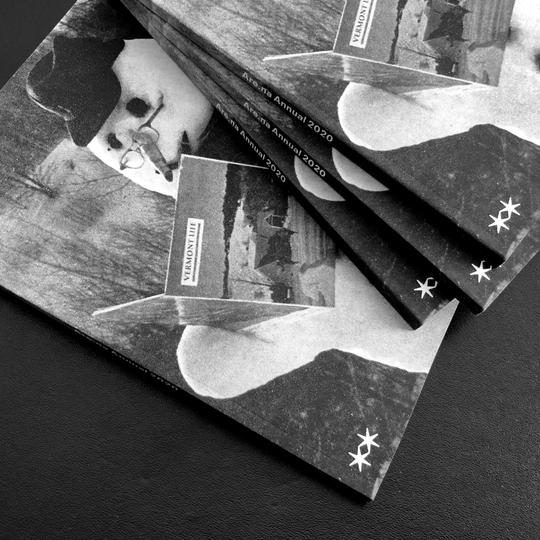 |
|||
| Design Talk with Studio Pandan | The Boy’s Club | in conversation | 2019 |
|
Together with Maddy Morley, we spoke to Studio Pandan about their approach to editorial design, how they work together as a studio, and why they're compelled by magazine making as a medium. |
|||
| Personal Photographs by Cory Arcangel | TB Editions | essay | 2019 |
|
I edited a piece written by Cory Arcangel for the Italian gallery The Blank Contemporary and its publishing arm TB Editions. The catalog was for Eva and Franco Mattes My Little Big Data and Cory wrote an excellent essay called “Personal Photographs” on “the ‘image world’ that both consumes us and fits so snugly into the palm of our hands.” I provided editorial guidance, a topedit, and a fact check. 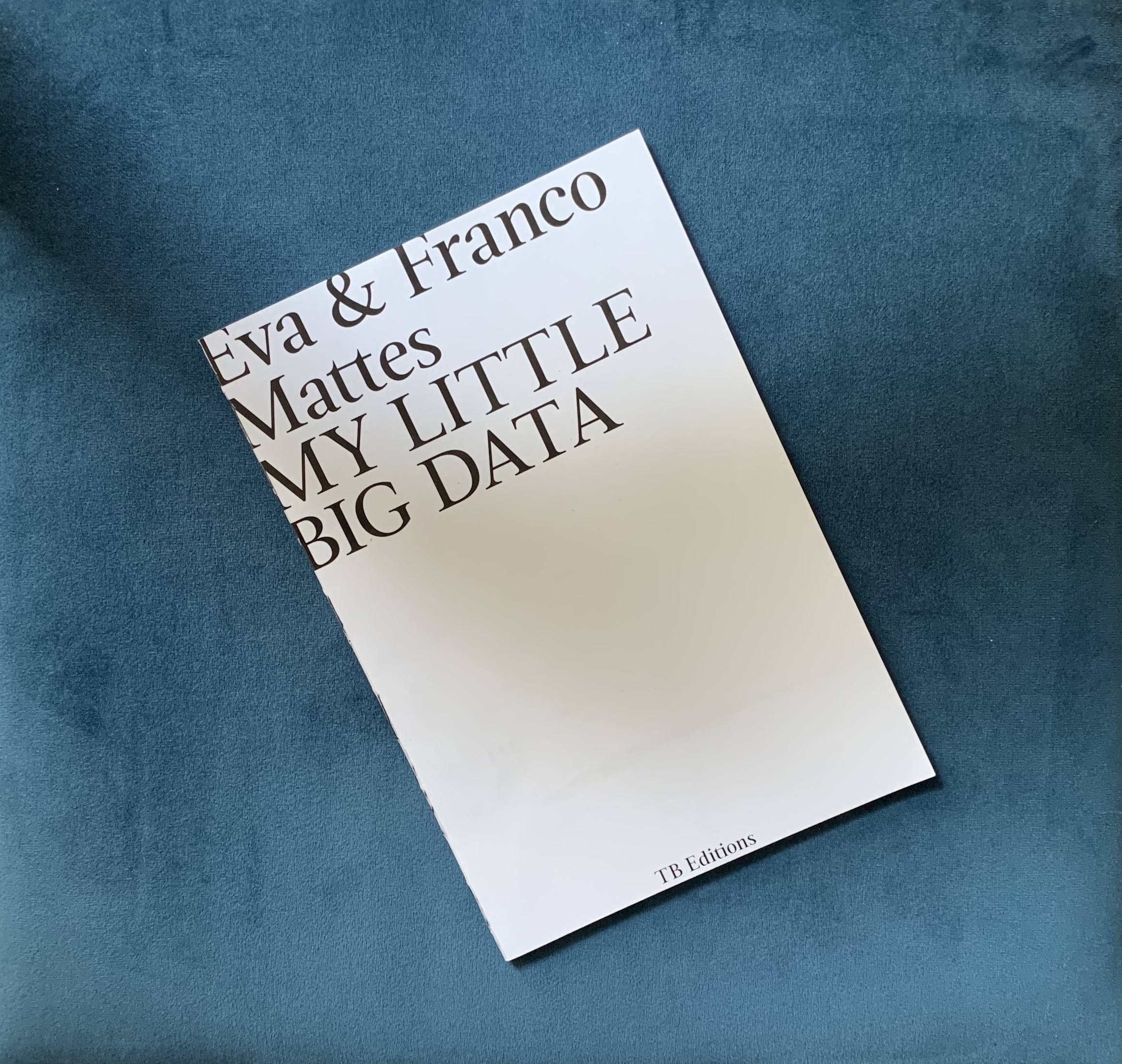 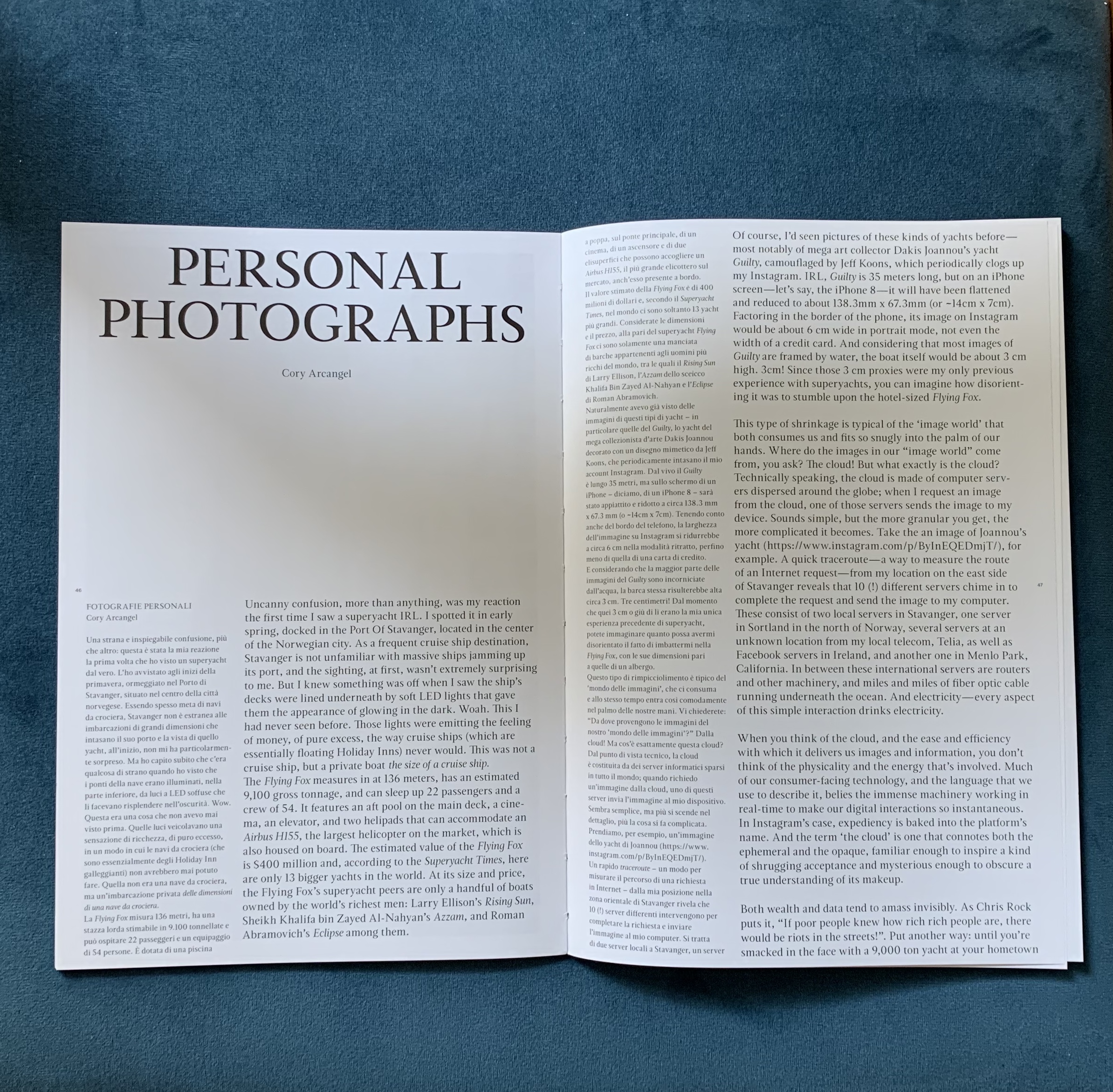 |
|||
| Reenvisioning the Internet series | Walker Reader | essays | 2019 |
|
For the Walker Art Center and Are.na, I edited a series of essays that asked artists and technologists to offer their hopes for the future of the web. |
|||
| Guest editor for “Writing as Metadata” class | Yale University | guest editor | 2019 |
|
For Laurel Schwulst’s “Writing as Metadata” class, I guest edited a student online publication called called The Life and Death of an Internet Onion. |
|||
| On Anna Della Subin | The Creative Independent | interview | 2019 |
|
A talk with writer Anna Della Subin on the virtues of idleness, procrastination as its own form of productivity, and the mythological power of sleep. |
|||
| Issue launch with Madeleine Morley | Athenaeum Books | talk | 2019 |
|
A talk on gossip and magazine making for the Amsterdam launch of the third issue of Eye on Design. |
|||
| On restaurant websites (and why we’re all going to miss them) | Are.na | interview | 2019 |
|
An interview with Toph Tucker and Jasmine Lee on restaurant websites as the last bastions of personality on the web, the tyranny and possibility of Squarespace, and the unseen labor of restaurant webmasters. Conducted with Laurel Schwulst as the part of a series of interviews hosted in our kitchen. H/t to Leo Shaw for the descriptors. |
|||
| On Sheila Levrant de Bretteville | Riposte | feature | 2018 |
|
“I’m much more a connector than a resistor. But when push comes to shove, I’m definitely a resistor.” A visit to the circular home of Sheila Levrant de Bretteville to talk about the Woman's Building in L.A., the shortcomings of the second wave, and design pedagogy seeped in activism. For Riposte magazine in London. |
|||
| On spelling spelling | The Serving Library | essay | 2018 |
|
An essay for The Serving Library’s Translation issue on the 19th century attempt to create a universal language by Alexander Melville Bell and the resulting alphabet of cryptic, otherworldly symbols codifying the articulation of speech sounds. Also includes: the Blue Ridge Mountains, Fran Ross’ Oreo, the placelessness of written speech, and the commendable effort to translate all the various "shades of sound." 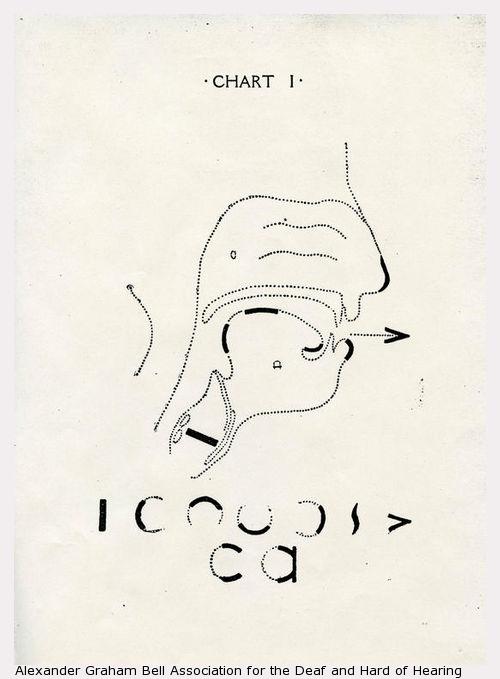 The Science of Universal Alphabetics by Alexander Melville Bell... |
|||
| Thesis students writing workshop | Parsons School of Design | workshop | 2018 |
|
A lecture and workshop on the beauty of simple, plainspoken language for thesis design students at Parsons. |
|||
| Visiting Critic | Rutgers University | crit | 2018 |
|
Visiting critic for thesis design students at Rutgers University during the fall semester 2018. |
|||
| Conference talk on independent publishing | Indiecon | talk | 2018 |
|
A talk in Hamburg on editing Eye on Design and publishing as a generative act. |
|||
| On seeing and being seen | Eye on Design | Essay | 2018 |
|
For Eye on Design issue one, themed Invisible, an essay on Alvin Lustig, who designed blind in his last years of life, and Elaine Lustig Cohen, who served as his eyes and hands before becoming a well-known designer in her own right. “I always say that either I would have remained this shy, unproductive person, or I would have grown up and divorced [Alvin] if he hadn’t died. I don’t know, because the person that I became would have never put up with what I was doing. But we’ll never know.” |
|||
| In-conversation with David Reinfurt | Google Design | in conversation | 2019 |
|
An intro and post-lecture interview with David Reinfurt on the life and work of Muriel Cooper. |
|||
| On Mierle Laderman Ukeles | Are.na | essay | 2017 |
|
For the Are.na blog, an essay on Mierle Laderman Ukeles, who was an artist-and-resident at New York City’s Department of Sanitation for three decades, on how her work drew a parallel between private domestic work and low-paying public maintenance work. Her Work Ballets, in which excavators, dump trucks, and street sweepers become graceful beings, bowing to commune with the ground, regarding each other curiously, or weaving in-between each other in a choreographed street dance, are some of my favorite pieces of art ever. |
|||
| Eye on Design magazine | AIGA | publication | 2017-2019 |
|
I edit the print magazine for Eye on Design, published by AIGA, the nonprofit professional organization for graphic designers. We publish three issues a year, each with a new theme and designed by a different designer, with the goal of telling stories that provide testimony to this moment in graphic design. |
|||
| Are.na blog | Are.na | publication | 2017- |
|
Since 2017, I’ve run a publication for Are.na that publishes interviews and essays following the threads of interest and pieces of research collected on the platform. Key topics include bettering the internet, experimental publishing, and continued learning, but the focus is mainly on personal projects that aren't a means to an end, and on following one’s innate curiosity and sleuthing interests. |
|||
| On the representation of women in movies and books | The Atlantic | feature | 2016 |
|
For The Atlantic, an article that explores how the representation of women in books and films is effected by the gender makeup of the industries that produce them. |
|||
| Visiting Professor | Parsons School of Design | workshop | 2023 |
|
A five week writing workshop for graphic design undergraduate students, as part of the Currents elective course in Communications Design. At the close of the workshop, Caspar Lam, Lynne Yun and I edited a book of student writing about their experiments with AI during the workshops and published it through Library Stack. |
|||
| On April Greiman | Eye on Design | interview | 2018 |
|
A longform interview with April Greiman, the designer who defined California New Wave, advocated for digital design early on, and created the poster/ publication “Does It Make Sense?,” a personal favorite. |
|||
| … | |||
